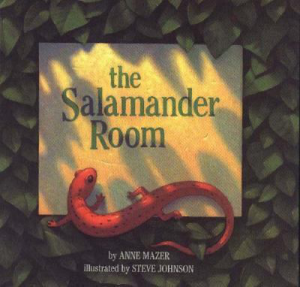 by Anne Mazer
by Anne Mazer
A boy finds a salamander in the woods and imagines the many things he can do to turn his room into a perfect salamander home.
Strategies/Skills Used
Reading Strategy 1: Access background information.
Reading Strategy 2: Predict what will be learned or what will happen.
Reading Strategy 6: Connect what you read with what you already know.
Reading Strategy 7: Determine the most important ideas and events and the relationship between them.
Reading Strategy 9: Identify and interpret literary elements in different genres.
Reading Strategy 10: Summarize what has been read.
Reading Strategy 11: Make inferences and draw conclusions.
Reading Strategy 12: Reflect and respond.
Writing Skill 4: I write so my thoughts flow smoothly and are easy to read.
 TEACHING THE ACTIVITY: PRE-READING
TEACHING THE ACTIVITY: PRE-READING
 (1) Hand out the scavenger hunt images, and invite students outside to search for the items on their list.
(1) Hand out the scavenger hunt images, and invite students outside to search for the items on their list.
(2) Have students find, sketch and label one item that is not on the scavenger hunt sheet.
(3) Gather students and lead a discussion about their scavenger hunt items. (What do they have in common? What do you notice about them?)
(4) Show students a picture of a palm tree and ask, “Would you find this tree on your hunt?” Discuss why or why not, drawing their attention to the habitat and climate around us. Have students suggest other things you wouldn’t find on this hunt and the reasons for it.
(5) Tell students that all of the items they were looking for are part of the story you are about to read to them. In small groups, have students predict what the story is about. Have each group share one idea with the class.
 TEACHING THE ACTIVITY: DURING READING
TEACHING THE ACTIVITY: DURING READING
(6) Pair up all students, and have them decide who will be Partner A and who will be Partner B.
(7) Read the story aloud and pause after each question that Mom asks.
(8) Using the Say Something activity, allow students to answer the questions using vocabulary from the scavenger hunt.
(9) Read Bryan’s response out loud after each partner has had a chance to predict and “say something.”
(10) Continue in this pattern until the end of the story. Have students compare their answers to those in the story, reflecting on content and process.
 TEACHING THE ACTIVITY: POST-READING
TEACHING THE ACTIVITY: POST-READING
(11) Summarize the story as a whole group using the Story Maps strategy and any one of the Story Maps #1, #2 or #3 Graphic Organizers.
(12) Have students focus on setting, characters, beginning, middle and end as you work through this process. This will help set them up for writing their own story.
(13) As the basis for their own story, invite students to imagine themselves walking through the woods and finding an animal of their choice.
 (14) Have students complete the story planning organizer A Habitat for a Wild “Pet“ or any of the Story Maps to plan out their own story.
(14) Have students complete the story planning organizer A Habitat for a Wild “Pet“ or any of the Story Maps to plan out their own story.
(15) Allow students sufficient time to write their story and provide them with opportunity to share.
 TEACHING THE ACTIVITY: POST-READING EXTENSION
TEACHING THE ACTIVITY: POST-READING EXTENSION
(16) Connections can be made to different habitats and different needs for animals in the same habitat.
(17) Do a Gallery Walk of the animals students have chosen for their “pet.”
(18) Discuss the implications of animals in captivity (e.g. complete a Venn Diagram – animals in the wild vs animals in captivity).